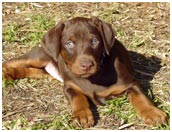
“only in the spirit of love, sacrifice and great cost will we bring our breed to a state of genetic excellence”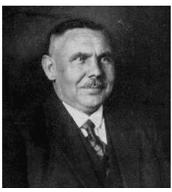 Philipp Grünig
Philipp Grünig
“Judge, scientific breeder and profound student of the Dobermann”


“only in the spirit of love, sacrifice and great cost will we bring our breed to a state of genetic excellence” Philipp Grünig
Philipp Grünig
“Judge, scientific breeder and profound student of the Dobermann”
Below is a translated transcript from pages 39–46 from the book 'Zucht und Sport mit dem Dobermann' by Dobermann Judge and breeder Ottmar Vogel. In this section of the book Ottmar Vogel writes about the von Ellendonk Kennel and their influence on the Dobermann breed.
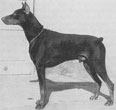 |
|
| Argus von Neroberg |
“Gina v. Fürstenfeld” (black, SchH 3) should be mentioned, as her breeding to an average male Lump v. Basterhof (black), produced the Bundessieger “Argus v. Neroberg” (brown, SchH 3), of the Kennel von Rauhfelsen, Breeder: Willi Rothfuss of Stuttgart. This dog was very powerful and compact with a very well-balanced character. Argus was often bred and today we still find his traits in the Ellendonk line in the Nordrhein region and partly in the Württemberg breeding region. He brought stability to the line with respect to substance and nerve.
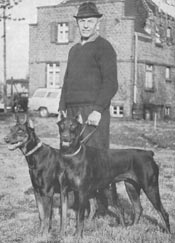 |
|
| Ellendonk breeder, Fritz Sauermann with (left) Dixi von Krakau and (right) Gerra von Ellendonk |
At that time the “von Ellendonk” Kennel, Owner E. and F. Sauermann of Krefeld, were talked about. The Sauermann married couple, were in nature basically training specialists who had previously achieved considerable success with Shepherds.
Their first female, “Dixi v. Krakau” (brown, out of Dirk v. Goldberg SchH 3 BDSG – Elke v. Saint Clemens) became D.V. Leistungssieger in 1964 in Bonn. I had seen the trial and despite her mistakes at that time, she left an outstanding impression and deserved the Sieger title. Anatomically this medium-size female earned "excellent" with slight faults. She is the foundation female of the von Ellendonk Kennel and asserted her traits through various males with respect to temperament. From the breeding with the Leistungsrüden “Astor v.d. Schimmel Schulz Heide” SchH 3 (multiple participant in D.V. Leistungsprüfungen) and “Dixi” came the Leistungssieger of 1966 “Gerra v. Ellendonk” and the Leistungsrüde “Gero v. Ellendonk” (brown, SchH 3). Both dogs consolidated the working abilities of this line and also were also always rated “excellent” at shows. “Gerra” was then bred with BDSG Argus v. Neroberg (brown, SchH 3). Out of the important “J-Litter” came some nice and good working dogs; such as: Jenny v. Ellendonk (brown, SchH 3), often V1 rated in conformation and the foundation female of the Kennel v.d. Räuberhöhle, Owner: Gero Müller in Göppingen.
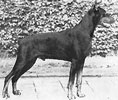 |
|
| Miko von Fürstenfeld |
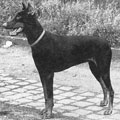 |
|
| Iris von Ellendonk |
Out of the “I-Litter” the BDSG Iris v. Ellendonk (brown, SchH 1) should be mentioned, as her breeding with Miko v. Fürstenfeld (black, SchH 1) produced the D.V. Leistungssieger of 1975, “Palma v. Ellendonk” (Black, SchH 3, Angekört for Life). Furthermore, the D.V. Leistungssieger of 1971 Immo v. Ellendonk (Brown, SchH 3), was not used for breeding.
 |
|
| Kora von Ellendonk |
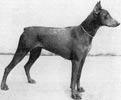 |
|
| Vesta von Ellendonk |
Many good working dogs came out of the von Ellendonk Kennel, with the Nordrhein region improving the poor/battered working reputation of the breed. The Sauermann's also produced some Siegers in beauty, such as BDSG Kora v. Ellendonk, SchH 1 (Sire: Argus v. Neroberg – Dam: Gerra v. Ellendonk); BDSG Iris v. Ellendonk (Sire: Gero v. Ellendonk – Dam: Palma v. Ellendonk); the blue DVSG Vesta v. Ellendonk SchH 1 (Sire: Fred v.d. Blütenstadt d'Orsoy – Dam: Dixi v. Krakau); the D.V. Jugendsieger Ulfas v. Ellendonk brown SchH 1, Angekört (Sire: Gero v. Ellendonk – Dam: Afra v. Honenstauf); the World Jugendsieger, Xyla v. Ellendonk SchH 1, Angekört (Sire: Gero v. Ellendonk – Dam: Palma v. Ellendonk).
Other noteworthy working dogs were also Satan and Sanko v. Ellendonk, both Angekört, and also the daughter of Sanko and Palma v. Ellendonk - Afra v. Ellendonk (Black, SchH 3, FH, Angekört for Life, V rated in conformation, owner Kennel v. Burg Böheim-Stein, H. Schauer, Pegnitz), and Trux v. Ellendonk, multiple participant at the D.V. Siegerprüfungen.
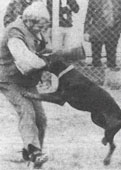 |
|
| Bingo von Ellendonk |
The best working dog was and, however, is the D.V. Leistungssieger Bingo v. Ellendonk (Sire: Jago v. Beelen, SchH 2, brown, Angekört for Life, BDSG, DVSG, Int.Ch. – Dam: Palma v. Ellendonk, Angekört for Life, D.V. Leistungssieger). This male at two years of age had already become D.V. Leistungssieger in 1977, and has since then, an unbroken succession where he has rarely been beaten out of anything less than second place. This male was titled over 30 times in SchH 3 and always captivated/impressed through his consistent work. He was taken to several European FCI Championships and constantly impressed with his enormous fighting instinct and his steady and strong nerves.
This male has been very interestingly bred and it may be said that the temperament traits have been inherited from both sides, as can be seen from the line of ancestors and the Blulinienplan. It is very encouraging that he has already left a strong working mark on his offspring and so it is hoped that the male continues to be intelligently and sensibly used for breeding. As is often naturally the case, this dog also has faults that come to light with certain matings.
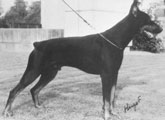 |
|
| Bingo von Ellendonk |
According to his reasonable conformation this dog is to be assessed as a high-SG-dog, he also already has an excellent rating (3rd place). In terms of his use, one should pay attention to his somewhat poor state in the forehand and his back, which is long and not quite firm. With his height of 68 cm, Bingo fits exactly into the medium-size range. It is of course, always difficult to maintain height. Presently, we are unfortunately swaying a little too much and we must try to stabilise the correct height for dogs at approximately 68–70 cm. Oversize as well as undersize will not meet our goal for building our working dog lines.
 |
|
| Ilo vom Kirchbühl |
 |
|
| Cora vom Papenkamp |
Bingo's first offspring were successes at the D.V. Siegerprüfungen in 1980 and 1981. In 1980, the two year old “Hexe vom Wilden Markgraf”, black, SchH 3, RHT, ADPr, (Sire: Bingo v. Ellendonk, SchH 3, IPO 3, FH, Angekört for Life – Dam: Bina v. Wilden Markgraf, SchH 3, IPO 3, FH, Angekört for Life) earned twelfth place with 275 points (SG rating) and in 1981 Ilo v. Kirchbühl, black, SchH 3, Angekört (Sire: Bingo Ellendonk – Dam: Cora v. Kirchbühl) earned 276 points in the D.V. Siegerprüfung, and also the D.V. Leistungssiegerin in 1981 Cora v. Papenkamp SchH 3 (Sire: Bingo v. Ellendonk – Dam: Afra v. Papenkamp) Körzucht.
 |
|
| Falk vom Rotbachtal |
Also interesting is the fact that both Hexe and Cora are similarly bred, in that both have the Leistungsrüden Falk v. Rotbachtal as a grandfather on their mother's side. Falk's Grandfather in turn, was the three-time Leistungssieger of 1961-1963 Fred v.d. Blütenstadt d'Orsoy. Here you can see with respect to their structure how such a line is built up.
 |
|
| Fritz Sauermann |
And now back to the Ellendonk Kennel. Some years ago, after the wife of the breeder passed away, Mr. Sauermann also ended his active work with the Dobermann. Nevertheless, there are several breeding animals with valuable genetics from this kennel, so hope remains to consolidate and improve on this foundation.
| Year | Litter | Sire | Dam | Pups | (Males/Females) |
|---|---|---|---|---|---|
| 1962 | “G” | Astor v.d. Schimmel Schulz Heide | Dixi von Krakau | 3/3 | (Gero, Gnom, Greif / Gerra, Gina, Golda) |
| 1964 | “H” | Basko vom Oberdahl | Dixi von Krakau | 2/4 | (Hassan, Heros / Hela, Hera, Hesta, Hexe) |
| 1965 | “I” | Fred v.d. Blütenstadt d'Orsoy | Dixi von Krakau | 3/3 | (Ilex, Immo, Ingo / Ilka, Imme, Iris) |
| 1965 | “J” | Argus von Neroberg | Gerra von Ellendonk | 3/3 | (Jago, Jaro, Jasso / Jana, Jenny, Jessy) |
| 1966 | “K” | Argus von Neroberg | Gerra von Ellendonk | 2/3 | (King, Kondor / Kelly, Kim, Kora) |
| 1967 | “L” | Mecki von Fürstenfeld | Dixi von Krakau | 0/1 | (Lyra) |
| 1967 | “M” | Andy vom Eichenhain | Jessy von Ellendonk | 5/1 | (Marko, Mecki, Milo, Morro, Mutz / Mira) |
| 1968 | “N” | Mecki von Fürstenfeld | Gerra von Ellendonk | 1/0 | (Nanko) |
| 1968 | “O” | Andy vom Eichenhain | Jessy von Ellendonk | 4/2 | (Odo, Onyx, Orest, Orlog / Orka, Ossa) |
| 1968 | “P” | Miko von Fürstenfeld | Iris von Ellendonk | 2/4 | (Phylax, Presto / Palma, Pandra, Perry, Petra) |
| 1969 | “Q” | Dux vom Rotbachtal | Gerra von Ellendonk | 1/1 | (Quell / Quinta) |
| 1969 | “R” | Miko von Fürstenfeld | Iris von Ellendonk | 6/0 | (Remo, Rex, Ricko, Ringo, Rondo, Rox) |
| 1970 | “S” | Gero von Ellendonk | Afra v. Hohenstaufen | 3/2 | (Sanko Satan Sorry / Senta Sandy) |
| 1970 | “T” | Boy von Stolzenfels | Gerra von Ellendonk | 3/3 | (Tasso, Trux , Troll / Tanja, Trixi, Truscha) |
| 1970 | “U” | Gero von Ellendonk | Afra v. Hohenstaufen | 4/0 | (Ulex, Ulf, Ulfas, Ustan) |
| 1970 | “V” | Chico von Forell | Jessy von Ellendonk | 2/4 | (Vasall, Vello / Vesta, Veva, Vilja, Viola) |
| 1971 | “W” | Orest von Ellendonk | Afra v. Hohenstaufen | 4/0 | |
| 1972 | “X” | Gero von Ellendonk | Palma von Ellendonk | 4/1 | (?, ?, ?, ?/ Xandra, Xyla) |
| 1973 | “Y” | Satan von Ellendonk | Vesta von Ellendonk | 2/4 | (Yago, York / Yarda, Yessy, Yuku, ?) |
| 1973 | “Z” | Sanko von Ellendonk | Palma von Ellendonk | 3/3 | (?, ? / Zamba, Zastra, ?) |
| 1974 | “A” | Sanko von Ellendonk | Palma von Ellendonk | 2/3 | (?, ? / Afra, Assy, ?) |
| 1975 | “B” | Jago von Beelen | Palma von Ellendonk | 1/2 | (Bingo / Barka, Bora) |
| 1977 | “C” | Hilo vom Norden Stamm | Assy von Ellendonk | 2/0 |